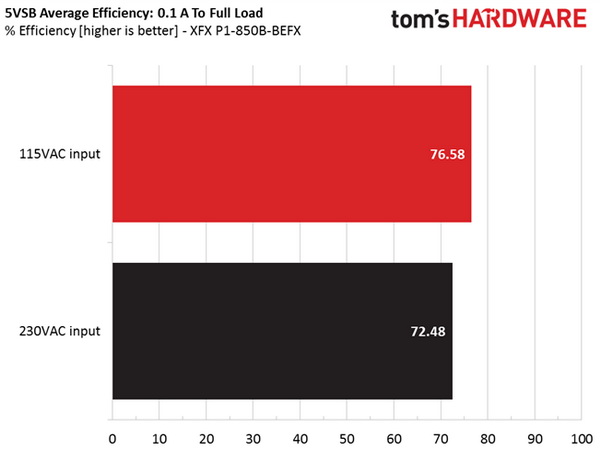XFX XTR Series 850W PSU Review
XFX cooperates closely with Seasonic for its PSU products. That's a major advantage, since Seasonic is a top OEM. The XTR line is XFX's second-best, after the XTS family, and today's review focuses on the 850W model.
Why you can trust Tom's Hardware
Efficiency, Temperature And Noise
Efficiency
Our efficiency testing procedure is detailed here.
Using results from the previous page, we plotted a chart showing the XTR 850W's efficiency at low loads, and loads from 10 to 110 percent of its maximum-rated capacity.




Efficiency is quite high, easily keeping up with the Gold-rated 750W units under both light and normal loads. The only 850W PSU in our charts, the Corsair CS850M, stays clearly behind especially at light loads.
Efficiency At Low Loads
In the following tests, we measure the XTR 850W's efficiency at loads significantly lower than 10 percent of its maximum capacity (the lowest load the 80 PLUS standard measures). The loads we dialed were 20, 40, 60 and 80W. This is important for representing when a PC is idle, with power-saving features turned on.
| Test # | 12V | 5V | 3.3V | 5VSB | DC/AC (Watts) | Efficiency | Fan Speed (RPM) | Fan Noise | PF/AC Volts |
|---|---|---|---|---|---|---|---|---|---|
| 1 | 1.198A | 0.490A | 0.475A | 0.194A | 19.62 | 70.20% | 0 | 0 dB(A) | 0.868 |
| 12.158V | 5.040V | 3.352V | 5.120V | 27.95 | 115.1V | ||||
| 2 | 2.422A | 0.989A | 0.984A | 0.390A | 39.72 | 80.44% | 0 | 0 dB(A) | 0.935 |
| 12.159V | 5.039V | 3.350V | 5.113V | 49.38 | 115.1V | ||||
| 3 | 3.653A | 1.474A | 1.491A | 5.104A | 59.83 | 84.51% | 805 | 32.5 dB(A) | 0.957 |
| 12.159V | 5.039V | 3.348V | 5.104V | 70.80 | 115.1V | ||||
| 4 | 4.869A | 1.983A | 1.970A | 0.780A | 79.73 | 86.20% | 805 | 32.5 dB(A) | 0.967 |
| 12.153V | 5.038V | 3.345V | 5.100V | 92.49 | 115.1V |
Even with 20W load, efficiency stays above 70%. As you can see from the fan speed column, the fan operates in passive mode only during the first two tests and its minimum speed is set at 805 RPM, which translates to 32.5 dB(A) output noise. If you are after a dead silent PSU, this one probably won't cut it.
5VSB Efficiency
The ATX specification states that 5VSB standby supply efficiency should be as high as possible, recommending 50 percent or higher efficiency with 100mA of load, 60 percent or higher with 250mA of load and 70 percent or higher with 1A or more of load.
We take four measurements: one each at 100, 250 and 1000mA, and one with the full load the 5VSB rail can handle.
Get Tom's Hardware's best news and in-depth reviews, straight to your inbox.
| Test # | 5VSB | DC/AC (Watts) | Efficiency | PF/AC Volts |
|---|---|---|---|---|
| 1 | 0.101A | 0.52 | 76.47% | 0.135 |
| 5.123V | 0.68 | 115.1V | ||
| 2 | 0.251A | 1.29 | 78.66% | 0.255 |
| 5.120V | 1.64 | 115.1V | ||
| 3 | 1.002A | 5.11 | 80.60% | 0.409 |
| 5.104V | 6.34 | 115.1V | ||
| 4 | 3.002A | 15.19 | 79.45% | 0.493 |
| 5.059V | 19.12 | 115.1V |


The 5VSB rail stands very well against other Gold-rated units in the 750W-850W range.
Power Consumption In Idle And Standby
In the table below, you'll find the power consumption and voltage values of all rails (except -12V) when the PSU is idle (powered on, but without any load on its rails), and the power consumption when the PSU is in standby mode (without any load, at 5VSB).
| Mode | 12V | 5V | 3.3V | 5VSB | Watts | PF/AC Volts |
|---|---|---|---|---|---|---|
| Idle | 12.164V | 5.041V | 3.356V | 5.128V | 11.13 | 0.663 |
| 115.1V | ||||||
| Standby | 0.10 | 0.022 | ||||
| 115.1V |


Power consumption at standby is very low; it doesn't exceed 0.15W even with 230V input.
Fan RPM, Delta Temperature And Output Noise
Our mixed noise testing is described in detail here.
The first chart below illustrates the cooling fan's speed (in RPM), and the delta between input and output temperature. The results were obtained at 38 °C (100.4 °F) to 49 °C (120.2 °F) ambient temperature.
The next chart shows the cooling fan's speed (again, in RPM) and output noise. We measured acoustics from one meter away, inside a small, custom-made anechoic chamber with internals completely covered in sound-proofing material (be quiet! Noise Absorber kit). Background noise inside the chamber was below 18 dB(A) during testing, and the results were obtained with the PSU operating at 38 °C (100.4 °F) to 49 °C (120.2 °F) ambient temperature.
The following graph illustrates the fan's output noise over the PSU's operating range. The same conditions of the above graph apply to our measurements, though the ambient temperature was between at 28 °C (82.4 °F) to 30 °C (86 °F).
Up to 160W load and under normal temperature conditions, the PSU's fan operates passively. Afterwards, it starts to spin briefly and then drops to passive mode again until the load exceeds 250W. For a wide range between 250W and 550W, the fan spins at its lowest speed (805 RPM) and exceeds 32 dB(A). Maximum noise is registered with >700W loads, and it falls within the 46-49 dB(A) range. In general, Seasonic could offer a more relaxed fan profile and not compromise reliability.
Current page: Efficiency, Temperature And Noise
Prev Page Load Regulation, Hold-Up Time And Inrush Current Next Page Cross-Load Tests And Infrared Images
Aris Mpitziopoulos is a contributing editor at Tom's Hardware, covering PSUs.


